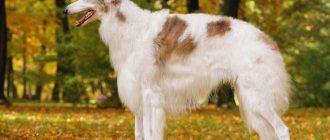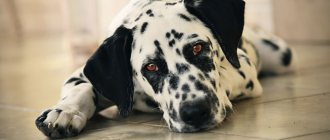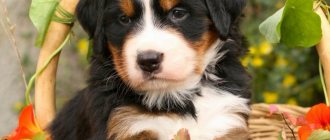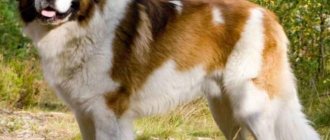Interesting facts about the Alanian fighting dog
It is noteworthy that in ancient times few Alanos were allowed to breed. The dogs were shown a bull, and if they began to rush at it, then the animal was considered suitable for breeding.
Representative of the breed
When grazing, Alanos can detain a cow or bull only by biting the animal’s ears or neck. They are taught this from childhood, because their ears heal quickly, and you can bend a cow by the neck without running into sharp horns.
History of the breed
The exact time of the appearance of the Alano dog breed cannot be determined, which is explained by their ancient history. According to some sources, in Spain, even during the reign of the Romans, large war dogs were set against bulls.
Scottish Setter Gordon: description of the dog breed
Throughout its existence, the Alan Dogo accompanied the Spanish warriors. Dogs helped soldiers in battle, on the road, and took part in cruel entertainment.
This is interesting! For a long time, mainly Alans took part in dog fights.
However, by the beginning of the twentieth century, this bloody event was banned, and its organizers began to be persecuted. At the same time, civil war broke out in Spain, and as a result, fighting dogs practically became extinct, as the people lost interest in them.
Revival of the breed
Only towards the end of the twentieth century, caring dog breeders organized a search for the remaining individuals and began to take measures to restore the population.
It was possible to find fifty representatives of this breed and, on their basis, it was possible to derive about a dozen pedigree lines. Preference was given to working qualities rather than external ones.
Now the Alan dog is the ancestor of many other breeds, and the Alanos themselves number about a thousand individuals. Russia accounts for only a few dozen.
Alano
Brief historical background
The origin of the Alan Dane, like other ancient dog breeds, is not known for certain . It is generally accepted that these animals first appeared in Spain in the 4th-5th centuries. They were brought with them by nomadic barbarian tribes, who used powerful strong dogs to protect their huge herds of cows and sheep from wild predators, as well as for hunting and during warfare.
According to one of the most popular versions, the breed got its name from these nomadic tribes - the Alans.
The first documented written mention of this breed can be found in the “Book of Hunting,” written by the famous medieval writer Juan Manuel back in the 14th century. This work describes in detail the exterior of the Alanos and their character. In Europe, Spanish bulldogs were called baiting bulldogs, since they baited a large animal (bear, bison, etc.) at the very end of the hunt. At the same time, dogs took an active part in bloody bullfights - popular spectacles at that time.
The medieval writer Juan Manuel in his “Book of Hunting” (Libro de la caza) describes dogs that are extremely similar to Alano
However, gradually, due to the reduction of hunting grounds, the breed became less in demand and popular. The number of dogs declined especially sharply after a law was passed (in 1883) banning the use of dogs in cruel entertainment. The population was on the verge of extinction, as Alanian Great Danes almost ceased to be bred. By the middle of the last century they were considered extinct.
In the 80s, an initiative group of veterinarians and dog handlers found several typical representatives of the original aboriginal breed, in whose veins there was no admixture of the blood of other Molossian dogs. Several breed lines were developed on their basis. The breed was completely revived only towards the very end of the 20th century.
Purebred Alanos still live in remote Spanish villages
In 1997, SEFCA (Spanish Society for the Breeding, Development and Support of Alanos) developed and adopted the first official breed standard. The Spanish National Dog Club recognized the Doga Alano as a separate breed in 2004, and the Ministry of Agriculture designated it as a native Spanish dog. International organizations, including the FCI, still do not recognize this breed.
In Russia, the Alanian Great Dane was registered in 2015, and at the same time a national club for lovers of this rare breed was organized.
Appearance of the Alano dog breed
The Alan dog, as it is sometimes called, owes its popularity largely to its frightening and menacing appearance.
Turkish Van (cat breed): description and features
The description of the breed looks like this:
- males can be up to 62 cm at the withers, females a little lower - up to 58 cm;
- the animal's body is strong and muscular;
- the head is square, tightly set on a wide neck;
- eyes are small in size and may be yellow, brown or hazel in color;
- Above the slightly concave lower jaw is a wide, triangular nose.
Additional Information! Short ears are cropped during puppyhood.
Alan color
Representatives of the breed are usually brindle in color. It is largely thanks to him that the breed became so widely known. However, there are also grey, black, red, red or fawn dogs.
Breed standard
The Spanish Bulldog belongs to the class of Molosser and Great Dane dogs. It is designed for baiting animals while hunting and protecting homes. The dogs are hardy and run well. Capable of traveling long distances.
Main characteristics of the breed:
- Features of behavior and character. Dogs have a balanced character. Alano are confident, but wary. Attached to the owner. Distrustful and moderately aggressive. Capable of making independent decisions.
- The type of constitution is strong. The muscles are sculpted. The skeleton is well developed.
- Height and weight. The Great Dane is a medium-sized dog. The height at the withers of males reaches 60–65 cm. Bitches are slightly lower - 56–61 cm. Height above this is not considered a fault. Lower height at the withers is a disqualifying fault. The weight allowed for males is 38–45 kg. Female stock is lighter: 33–38 kg.
- Alan Espanyol has an elongated format.
- The coat is short. The cover is dense on the back, sparse on the chest. The rough fur on the tail is arranged in the form of a spike.
- The predominant color of the Spanish Bulldog is brindle. Possible shades from light fawn to copper. Gray colors are allowed. Blackness on the face is welcome. The overall tone is uniform. Large white spots are considered a fault.
- The dog's head is large, heavy, and rough. The forehead is wide. The transition to the nose is clearly pronounced.
- The ears are set wide apart and fit tightly to the skull. Cupping is encouraged.
- Alano eyes are medium in size and highly expressive. Acceptable color ranges from dark yellow to brown. Disqualifying defect: blue eyes.
- The teeth are large and strong. The Alano has a slight undershot: the lower jaw protrudes forward. A pincer bite is allowed: the upper and lower incisors are aligned with each other. An undershot exceeding 3 cm is a disqualifying fault.
- The neck is massive, of medium size and dewlap.
- The dog's withers are slightly protruding.
- The back is wide, strong muscles are visible and a deflection is indicated.
- The loin is broad, with excellent muscle development.
- Alano croup is medium length, rounded. Situated slightly above the withers. A croup dropped below the withers is a disqualifying fault.
- The tail is rough and dense, set slightly below average. It descends to the hock joint. If it ends higher, it is a disqualifying fault.
- The chest is wide, powerful, with superbly developed muscles, dropped deeply. Weak breasts are considered a disqualifying defect.
- The Spanish Alano's belly is lean and tucked towards the back. The sides are sunken.
- The forelimbs are straight and strong. The paws of the Alano Hispaniol look parallel from the front. The long, sloping shoulder is positioned at a right angle, ensuring that the elbows are close to the dog's body. Pasterns are short. The bone on the metatarsals is thinner.
- The hind limbs are straight and parallel, set apart. The muscles are well defined. Hips are powerful. Strong hock joints form an obtuse angle. Dewclaws are completely absent.
- The movements are light and relaxed.
General disqualifying faults: gross deviation from the standard, cryptorchidism.
Disqualifying defects and shortcomings
Snowshoe (cat breed): features and appearance
There are deviations from breed standards that are considered unacceptable. If the dog has any, the expert has the right to disqualify him. These vices include:
- blue or light eyes;
- undershot (more than 3-4 mm);
- poorly developed chest;
- small stature;
- cryptorchidism.
In addition to all of the above, a dog with serious behavioral abnormalities or a poor nervous system is not allowed to participate in the exhibition and breeding.
Character and psyche of the breed
Despite its bloody history and terrifying appearance, a healthy Alano dog has a calm and balanced temperament. She is not prone to displaying causeless aggression or excessive activity.
The dog has a healthy instinct to protect its territory and its family members. She is wary of strangers. In a family, the dog determines the leader and obeys only him. Other family members can count on attention and respect, but you should not expect unconditional obedience from the dog.
Dog and child
The Alanian Great Dane is quite loyal to children, but will not tolerate harsh games with pulling the ears and tail, and may display a natural defensive reaction. It is better not to leave a small child alone with a dog without attention.
Purpose of the breed
Ears are cropped in puppies.
Before you take a dog into your home, you should familiarize yourself with its characteristics.
Character and psyche of the breed
Peculiarities of the psyche of the Alano breed:
- despite its history and menacing appearance, a healthy dog has a calm and balanced temperament;
- there is no tendency to causeless aggression;
- does not behave overly active;
- there is a healthy instinct to protect one’s territory and relatives;
- are wary of strangers;
- in the family, determines the leader and obeys only him;
- treats children well, but cruel treatment of the dog will lead to his defensive reaction.
Alans have excellent relationships with children
Characteristic features of the behavior of the Alanian fighting dog
The character is distinguished by the following features:
- courage;
- nobility;
- perseverance;
- ability to endure pain;
- excitement;
- temperament.
Judging by the characteristics of Alan, it is clear that dogs can be reliable human friends, helpers and hunters. They don't attack. They can show aggression if a person does not understand the warning from the dog.
Important! Dogs are loyal to children and protect them, taking part in games.
Alans are good companions and friends of man
Pros and cons of the breed
Before purchasing a dog, the future owner should familiarize himself with the advantages of the breed:
- the dog is calm and peaceful;
- understands its owner due to intonation;
- builds good relationships with children;
- has dominant investigative and security functions.
It is also worth taking a closer look at the disadvantages:
- the dog needs to be walked at least 3 times a day;
- the dog needs a lot of physical activity and active games;
- The main preference is to keep them in an enclosure in a country house.
An aviary is considered a preference for dogs
Raising and training the Spanish Alano
A serious and temperamental dog needs a strong leader who can lead. The tendency to dominate is present in the genes of all Alanos, so they should be raised from childhood.
The first commands can be taught from two months. Basic “sit”, “lie down”, “place”, “come to me”, “ugh!” must be mastered without fail so that the owner can apply them in everyday life. In addition to convenience in everyday life, learning commands provides the dog with the necessary mental stress, which allows the puppy to develop harmoniously.
When walking, you should not leave the Alan dog to its own devices. Walking only in the company of other dogs is also not recommended.
Important! Socialization is certainly a very important process, but in addition to communicating with dogs, the Alano must have strong contact with its owner.
Therefore, during walks, it is necessary to repeat the learned commands and play with your pet.
Content
Interestingly, Alanos are capable of climbing trees and jumping well. This breed needs frequent and active walks. This feature of the content makes it easier to keep them in a country house. A dog's diet is directly affected by their lifestyle. In the city, without additional exercise, it is necessary to count calories, avoiding obesity. It is necessary to maintain a balance of nutrients in the diet. You cannot give sweets, bones, bread. If a decision is made to give the animal dry food, homemade food should be excluded.
It is very easy to care for the coat - just brush twice a week with a stiff brush. Should not be washed frequently. Most dogs of this breed are in good health.
Alano dog care and nutrition
The Alano's coat is short and does not require special care. Claws grow quickly and need to be trimmed regularly so that they do not cause discomfort to the animal when moving.
A dog needs many beneficial substances that it can only get from food. That is why the diet must be individually selected to suit the dog’s needs.
Nutrition for puppy and adult dog
Alanos accept dry food well. Provided that the food is chosen correctly and satisfies all the physiological needs of the dog, there will be no problems. For puppies, it is better to soak hard granules in water beforehand.
If we are talking about natural food, then the portion should include lean meat, dairy products, cereals and vegetables. If necessary, the diet is supplemented with vitamins.
Care and maintenance
Representatives of this breed have good health and do not cause any special problems in care. To live a comfortable life, a dog needs to lead an active lifestyle - run a lot.
Representatives of the breed jump very high and can climb trees. This feature must be taken into account when constructing an enclosure.
It would be ideal to keep the Alano outside the city, where the animal has enough space to play and run around. In urban environments, it is necessary to devote at least 2 hours a day for active walks, and also monitor nutrition so that the pet does not overeat.
In addition to standard visits to the veterinarian for examination, vaccinations and worm prevention, it is necessary to keep the dog’s ears clean and trim its nails on time. There is no need to wash your pet with shampoo. To care for the coat, it is enough to bathe in plain water and brush it weekly with a massage brush.
Alan Dane nutrition
Dogs accept ready-made dry food and natural food equally well. You should choose only high-quality food from well-known manufacturers. When feeding, they are not given any other additives, with the exception of a treat in the form of a sugar bone.
Natural feeding includes:
- meat and offal (beef, goat, horse meat, chicken);
- dairy products (kefir, low-fat cottage cheese, natural yogurt);
- vegetables and fruits (cabbage, carrots, pumpkin, zucchini, apples);
- cereals (rice porridge, buckwheat, oats).
Special supplements will help replenish your diet with vitamins and microelements.
A dog is a predator, the basis of its diet is meat, the share of which should make up more than half of the daily menu.
The owner must remember that treating a pet to food from a human table is strictly prohibited. Eating salty, peppery foods and sweets can lead to illness.
Diseases
The life span of large dogs is short-lived; the lifespan of the Alan Dane is limited to 12-13 years. But representatives of the breed have good health. No serious hereditary defects inherent in Alano have been identified. The exception is the scourge of all large dogs - hip dysplasia. To protect yourself from becoming acquainted with this disease, you should choose a puppy only from well-known nurseries, from parents without signs of the disease.
Mating
As with many large breed dogs, the first heat in Spanish Alano bitches occurs at the age of one to one and a half years. But it is better not to breed a dog during its first heat, regardless of whether it is a female or a male. This can lead to the birth of sick offspring.
Dogs should not be bred earlier than 5-6 days after the start of estrus. It is best to organize mating on the territory of the dog, and introduce the dogs in a neutral zone. On her territory, a bitch can show aggression and drive away a representative of the other sex.
It is not recommended to interfere with the process, since animals are guided by instincts and can show aggression.
Origin of the breed
The dogs gained considerable popularity in Spain, where they are known under the names: Spanish Alano or Alano Hispaniolo. Introduced to the country hundreds of years ago and adapted to the conditions of the area, the dogs were used in bullfighting. Together with the Spanish conquerors, the dogs came to the New World, where they were used for hunting and more terrible work - capturing runaway slaves.
With bloody entertainment and hunting for large animals becoming a thing of the past, the Alano dog breed almost ceased to exist. Only in the second half of the 20th century, thanks to the hard work of Spanish dog handlers, the revival of the breed began. Until now, it has not been recognized by the International Cynological Community; there are only standards developed by Spanish breeders.
Choosing an Alano puppy
Purchasing a puppy from a kennel with a good reputation is a big advantage. This reduces the risk of buying a mongrel.
Puppy
Puppies should be playful and moderately curious. If the baby hides in a corner and does not participate in the general fuss, most likely he has hereditary problems with the nervous system. It is difficult to predict the character of a future pet, so it is worth looking at its parents.











